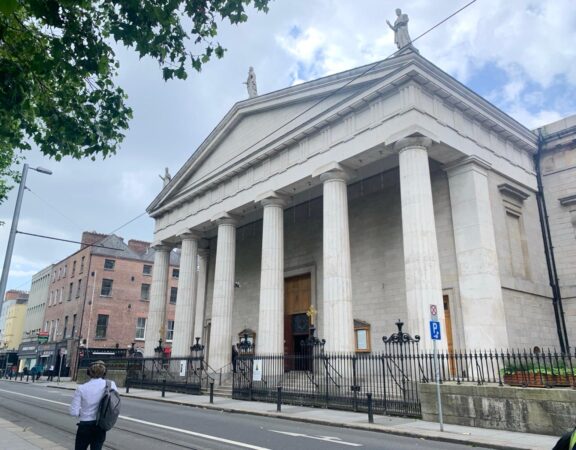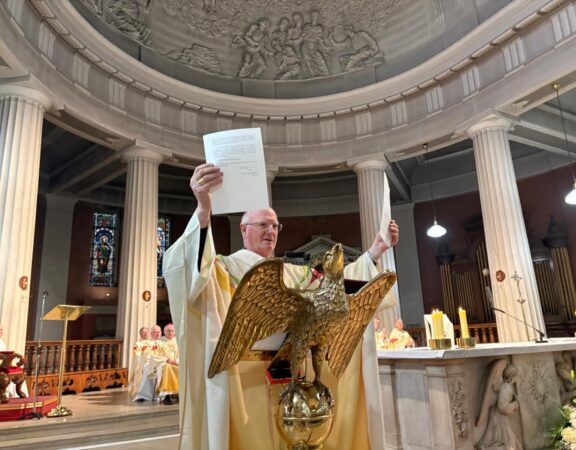Presentation of the Book
“The Vatican” by Michael Collins
“The Vatican” by Michael Collins
Speaking Notes of
Most Rev. Diarmuid Martin
Archbishop of Dublin, Primate of Ireland
—————-
5th November 2008
Most Rev. Diarmuid Martin
Archbishop of Dublin, Primate of Ireland
—————-
5th November 2008
As many of you know, I worked in the service of the Holy See for many years. My CV records some of the particular tasks I was assigned at the Pontifical Council for the Family and the Pontifical Council for Justice and Peace, as well as in the Diplomatic Service of the Holy See in the area of multi-lateral international relations, both during my time in Rome and as the Representative of the Holy See in Geneva at over twenty different international organizations of the UN, the World Trade Organization and others.
But there are some things that normally do not find themselves in my CV. One, for instance, is that I was a judge in the Vatican, quite an achievement for someone with no juridical training. Now most people, if they think of a judge in the Vatican, think perhaps of the judges of the Holy Roman Rota examining the details of the validity of marriages or of other tribunals examining the holiness of candidates to Sainthood.
My experience was a little more mundane. I was one of the three founding judges of the Vatican Labour Court. You might think that that was not the busiest of posts and probably not the most in modern in terms of contemporary labour standards. In fact, it was one of the significant signs of modernisation within the internal workings of the Vatican, which Father Michael Collins describes in his book as an “enigmatic city within a city”.
His book shows the variety of aspects of the life of the Vatican, the centre of the ministry of the Pope as the one chosen to be the bond of unity of the Catholic world and indeed of encounter with the entire Christian world. The Vatican is unique as a centre of cultural heritage, with its official museums, but also as a place where art and history jump out at you from every corner and where there is a desire to ensure that the best of the past is enriched by the contribution of contemporary art and architecture. I had the pleasure to live within ten meters of Saint Peter’s Basilica on one side, and the remarkable example of contemporary architecture, Pier Luigi Nervi’s Audience Hall on the other.
The Vatican is a place of dialogue between faith and the modern world, with its international academic institutions and academies. The Vatican is a forward-looking modern institution; it is, for example, as is pointed out in Father Collin’s book, “the first carbon-free State in the World”.
Within this city of significant world focus there is the smaller world of those who ensure that the wheels of the institution keep running. Liturgies run perfectly because of the minute planning of a large team of liturgists, sacristans those charged with the conservation and maintained of liturgical artefacts and vestments. Thousands come to liturgies and each finds the place assigned to them, from those who are waiting at dawn for the best place along the aisles, to the kings and head of state who arrive at the last minute, at times with a few extra members of their party, for whom as appropriate gilt chairs discretely emerge from nowhere.
The Vatican depends on an effective administration to look after the maintenance of the fabric of buildings, and to ensure the challenging task of a security system which is strict yet not intrusive. Art works are restored and maintained mainly by the Vatican’s own artistic directors and hand workers, whose task they understand as a genuine mission. I remember well the day that Michelangelo’s’ Pietà was damaged and the sense of sadness, almost of sacrilege, that every Vatican worker felt and I remember the pride on the day that this extraordinary work was once again opened to the public after its restoration, carried out by the Vatican’s own staff to the highest standards.
There is the challenge of providing the day to day services of keeping roads in order – I remember well the introduction of the first traffic lights in the Vatican – to seeing that electricity and cleansing services work, to a printing press that produces a daily newspaper and elaborate pontifical documents, in addition to the more mundane business of printing visiting cards of ambitious monsignori and wedding invitations for proud lay employees.
The Vatican is a little world of its own, open to the world. All its services are provided by a workforce which is as dedicated as any I have ever encountered and with a pride in their work, which in many cases has been carried out over generations within their families.
My work in the labour court was just another example of the desire by the Pope of the time, Pope John Paul II, to provide the work force, mainly lay, with a modern framework of labour law and remuneration, of rights and correct procedures, alongside other services such as the efficient health service provided to Vatican employees and their families.
Father Michael Collin’s book captures so many of these aspects of life in the Vatican, from the intensely religious and the richly cultural to the everyday life of this smallest of States, whose influence around the world it would be wise not to underestimate.
The book is stimulating and interesting reading for a broad public and indeed for someone like myself for whom the Vatican was home for more than half my life.






